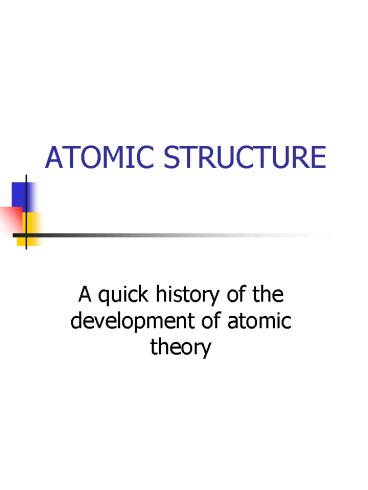ATOMIC STRUCTURE - PowerPoint PPT Presentation
1 / 12
Title:
ATOMIC STRUCTURE
Description:
ATOMIC STRUCTURE. A quick history of the development of atomic theory. Democritus (460-370 B.C. ... 1st to propose that all matter was composed of tiny ... – PowerPoint PPT presentation
Number of Views:125
Avg rating:3.0/5.0
Title: ATOMIC STRUCTURE
1
ATOMIC STRUCTURE
- A quick history of the development of atomic
theory
2
Democritus (460-370 B.C.)
- 1st to propose that all matter was composed of
tiny individual particles he called atomos. - Atomos (atoms) could not be created, destroyed or
futher divided - Not widely accepted due to more influential
philosophers of his day (Aristotle) who
challenged him to prove it.
3
John Dalton (1766-1844)
- Daltons Atomic Theory was proposed in 1803
- All matter is composed of extremely small
particles called atoms - All atoms of an element are identical having the
same size, mass, and chemical properties. Atoms
of one element are different from atoms of any
other element.
4
Daltons Atomic Theory (cont)
- Atoms cannot be created, divided into smaller
particles, or destroyed. - Different atoms combine in simple whole number
ratios to form compounds. - In chemical reactions, atoms are separated,
combined, or rearranged.
5
The Electron
- Study developed from the discovery of negatively
charged particles with the use of a cathode ray
tube. - All matter showed evidence of having these
negative particles - J.J. Thomson (1856-1940) is credited with the
discovery because his experiments showed that
this mysterious negative particle was MUCH, MUCH
smaller than an atom
6
The Electron
- Robert Millikan (1868-1953) provided important
details such as the exact charge of the electron
(Millikans Oil Drop Experiment). - This helped to calculate the exact mass of the
electron - Masselectron 9.1 x 10-28 g
- Thomson proposes the plum pudding model of the
atom. (i.e. negatively charged electrons were
distributed throughout a uniform positive charge.
7
The Nuclear Atom
- Ernest Rutherford (1871-1937) discovers a highly
dense positive center of the atom using his
famous experiment using gold foil and alpha
particles in 1911 (diagram on p.95). - But studies showed the atom was too heavy.
8
The Neutron
- James Chadwick discovered the neutron in 1932
- The neutron has a mass very similar to that of
the proton, but carries no electrical charge.
Chart found on p.97 of text
9
The Elements
- Matter as we know it is made up of atoms of
different elements - There are over 110 known elements
- Each element is defined by how many protons are
found in its atoms nucleus. This is called the
elements atomic number - In a neutrally charged atom
- of protons of electrons
- The mass number of an atom is
- mass number protons neutrons
10
Atomic Mass
- Atomic masses of elements are measured in Atomic
Mass Units (amu) - The amu is defined as exactly as the mass of the
carbon-12 atom - What we see in the periodic table is the average
atomic mass of an element
11
Isotopes
- Not all atoms of an element are identical!
- An isotope is an atom of an element that has the
same number of protons but a different number of
neutrons - The average atomic mass of an element is found
from adding up the mass numbers of each isotope
with regards to their natural abundance.
12
Atomic Mass Calculation
- Mass contribution of the isotope
- mass contribution
- (atomic mass of isotope)(natural abundance)
- Add up the mass contributions of each isotope
- avg atomic mass
- mass contribution 1 mass contribution 2 ..































